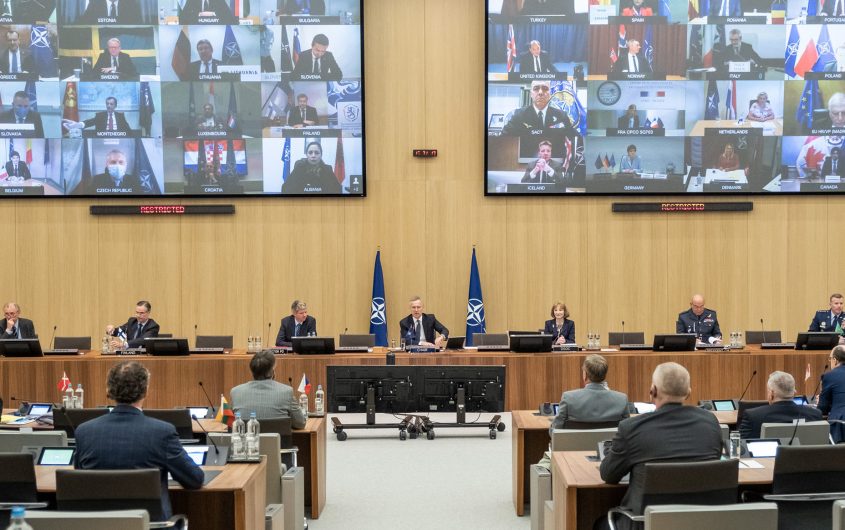
NATO via Flickr
After the Coronavirus: A More Digital and Greener Transatlantic Economy?

Peter S. Rashish
Vice President; Director, Geoeconomics Program
Peter S. Rashish, who counts over 30 years of experience counseling corporations, think tanks, foundations, and international organizations on transatlantic trade and economic strategy, is Vice President and Director of the Geoeconomics Program at AICGS. He also writes The Wider Atlantic blog.
Mr. Rashish has served as Vice President for Europe and Eurasia at the U.S. Chamber of Commerce, where he spearheaded the Chamber’s advocacy ahead of the launch of the Transatlantic Trade and Investment Partnership. Previously, Mr. Rashish was a Senior Advisor for Europe at McLarty Associates, Executive Vice President of the European Institute, and a staff member and consultant at the International Energy Agency, the World Bank, UN Trade and Development, the Atlantic Council, the Bertelsmann Foundation, and the German Marshall Fund.
Mr. Rashish has testified before the House Financial Services Subcommittee on International Monetary Policy and Trade and the House Foreign Affairs Subcommittee on Europe and Eurasia and has advised three U.S. presidential campaigns. He has been a featured speaker at the Munich Security Conference, the Aspen Ideas Festival, and the European Forum Alpbach and is a member of the Board of Directors of the Jean Monnet Institute in Paris and a Senior Advisor to the European Policy Centre in Brussels. His commentaries have been published in The New York Times, the Financial Times, The Wall Street Journal, Foreign Policy, and The National Interest, and he has appeared on PBS, CNBC, CNN, NPR, and the BBC.
He earned a BA from Harvard College and an MPhil in international relations from Oxford University. He speaks French, German, Italian, and Spanish.
As Austria, where the coronavirus curve appears to be flattening, and other parts of the European Union cautiously reopen for business, it may not be premature to draw some initial economic lessons from the pandemic for the transatlantic relationship. If so, the digital and green economies—and their interconnection—could be two of the sectors that will get the biggest boost.
All of us are participating in and witnessing important shifts in behavior. Around the world many people are staying or working from home instead of driving their cars to factories and offices. Families are taking walks in their neighborhoods rather than using private or public transportation to go to gyms, sports fields, and public parks. And when needed, they are relying on telemedicine in place of doctor visits. Even governments are holding high-level meetings online.
These changes can be appreciated in visually striking ways, as the decline in industrial output and transportation from the lockdowns across the globe has led to significant reductions in emissions of nitrogen dioxide, a key contributor to global warming. Output of CO2, another cause of climate change, is also down. At the same time, the jump in working from home has led to a twenty-fold growth in the use of Zoom, a virtual meeting platform. The result is that while the global economy has shrunk, it has also become more digital and more environmentally friendly.
While the global economy has shrunk, it has also become more digital and more environmentally friendly.
After COVID-19 subsides, what are the chances a U.S. or German company will go back to the old ways of operating? While some business needs to be done in person, perhaps firms will decide that using digital technology can be just as efficient as air, rail, or automobile travel to conduct meetings and in a way that significantly reduces the global carbon footprint.
If this pandemic is not a one-off but rather (and worryingly) a harbinger of what is to come, the case for investing in a more digital and thus a greener economy may make sense. This is particularly true for manufacturing.
Today’s global value chains are highly specialized, often with just one supplier in a far-flung market for a particular part. In normal times this arrangement helps to keep costs down. But this lack of redundancy makes the global economy less resilient in a crisis like the current one: if shipping or air connections are disrupted, companies can’t easily find short-term alternative suppliers. That also adds costs.
To square this circle, it is likely that companies will move increasingly to use additive manufacturing (3D printing) that allows design and production of a wide range of parts at short notice and closer to home, easing reliance on inputs transported from abroad. Governments and firms can be expected to invest in other new technologies that will allow not only for service providers like doctors and lawyers, but also manufacturing companies to conduct their work over digital networks, thereby increasing resilience to shocks in the physical world.
But disruptions can also happen in the digital world, meaning that the U.S. and the EU will need to pay more attention to the security of 5G networks that can play an important role in advanced manufacturing.
It also suggests that a key priority, once the next U.S. administration takes office, should be to negotiate an ambitious U.S.-EU digital trade agreement that incentivizes moving business online, which could stand on its own or be part of something bigger. A broader deal could also include high environmental standards—something greater digitalization would in any case help the U.S. and the EU to meet.








